|
|
||||
|
By Jo Nova It’s a fantastic piece of engineeringLast week my EPL tendon went snafu. For no reason, my left thumb just stopped doing what it always has. It didn’t hurt, but it didn’t work. It was rather disconcerting. I wondered if it was the first sign of some hideous degenerative nerve condition that would put me in a wheelchair. But after searching with the dreaded Dr Google, I figured out I’d just torn the EPL tendon. Who knew tendons can wear away painlessly and break? Who knew we can diagnose these things without an xray, just with an eyeball? So, I had surgery in hospital yesterday to fix it. I looked at anatomy drawings and it dawned on me, we can see all the tendons on the back of our hands if we flex them the right way in the right light. And by golly, my right thumb had two tendons, but my left only had one. It was so obvious. Have a look at your own hand. We have two long tendons running down the back of your index finger and pickie* (though these look like one single tendon on our fingers, the two are obvious on our thumbs). Essentially, one tendon pulls on the top knuckle, and one pulls on the one below. These cords run down our hands through tunnels that keep them neat — like rolling over pulleys. They run right over our wrists and connect to muscles attached to the long bones of our forearm. Every time you wiggle your fingers, muscles are tugging from somewhere deep in your forearm, a long way from your hand. Somehow as babies we all learn which muscle moves each knuckle to get full finger control. No wonder it takes months to learn fine motor skills… Look at your tendonsThe classic test for the torn long thumb tendon, apparently, is to place your hand on the desk and lift up your thumb. So this is me, trying to lift my left thumb. Nothing. No action. No cord under the skin. I’d never paid attention to the ridges that flowed before. But it’s so cool… Tendon breaks can occur with a long delay after a bone injury. I broke my arm two years ago iceskating. As the tendon stretched over the wrist, either the screws or bone scars abraded the tendon. Apparently they can’t be repaired easily after being shredded. Obviously, I needed to take out the metal hardware in my wrist too, lest it degrade the replacement. On Monday I casually sent an email with my self-diagnosis to the surgeon who fixed my broken wrist two years ago. I must have been very convincing because 30 minutes later I got a phone call from his secretary saying I was booked in for surgery “Thursday”! That was a shock. Pandemonium hit my diary. So, yesterday I had the plate and screws removed, and a tendon graft and an overnight stay. The surgeon took one tendon from the index finger to restore control of the thumb. Apparently we don’t miss the extra extension on the finger as much as we do on the thumb — the ultimate prehensile tool — as I keep explaining to my cat. My arm is in a half cast. I’m typing slowly. I started this post a week ago. And naturally after the secretary called, I sought second opinions. I was lucky enough, as a writer in the underworld of science, to get free advice from a GP, an orthopedic surgeon and an anesthetist. How rich am I? For the next 3-6 weeks I’ll be typing less. Posts will be shorter. Sorry. I’ll do my best… *Corrected. I thought we had two tendons on each finger, but it is not so — the middle two fingers only have one. For some reason we must need slightly more control with two tendons on the index and pinkie finger.
By Jo Nova Sometimes we just need to pay attention to what adversaries are doing. Why would China be so worried about foreign EV’s near airports and holiday resorts of VIPs? Winston Sterzel spent 14 years in China and has some of the best insights and connections behind the propaganda wall.
I am unavoidably distracted by other things for the next two days. Sorry I will not be able to reply to emails or comments. Thanks to the moderators for keeping the ship running. h/t John Connor, Furiously curious, Kim, and RexAlan
By Jo Nova Geoff Buys Cars is a car nerd commentator who spent hours trying to find evidence that the Luton airport fire was caused by an EV. To recap — 1,200 cars died, the floor collapsed, the airport fielded 16,000 calls from people who needed help, answers, another flight, or their charred car. It was a big deal to a lot of people, and he argues, a turning point in the quest to get everyone driving an electric vehicle. In the end officials say it was a diesel, and Geoff couldn’t definitively show it was or wasn’t an EV, but he said it doesn’t matter — everyone thought it was an EV anyway, and he argues — it will destroy electric car sales either way. If everyone else thinks it’s an EV then there is no way people are walking into car dealerships this morning with that in the news and saying “you know what, I really fancy parking one of those lithium powered electric vehicles right outside my house. I think that’s exactly what I need to do to save the planet and look after my wallet and my family.” Today, he said, people are phoning car dealers and asking if they change their order to the 1.2 Petrol… That was the first day after the Luton fire, but a week later he’s still hunting for the details and the plot thickens, what a hunt, through an ocean of contradictory information. He’s got quite the witty style… Start at 1 The shortest summary I can make: Early news reports said it was an EV or a hybrid but try finding those now… he says. Then they said it was an Evoke, but it wasn’t, then it might be a “Sport”, and the story kept changing. He wonders why images of the numberplate started circulating when he could not see those details in the video, no matter how he enhanced, magnified or worked on the image. And did the numberplate start with an A or an E? Days later, why did someone suddenly form a new account that had not posted before, and release a video from the front of the car that was only 4 seconds long? Why are the owners staying silent. Why haven’t they told us what the car was? With so many mysterious questions he adds: It’s not like some nefarious group within the government wants to suppress the news of the frequency and severity EV Failings It’s not like EV sales are stalling… It’s not the one guy who contacted me about a Tesla fire who said the police even told him to delete the photos, not take any more and don’t tell anyone… (the police!) Maybe this is a bigger story than we think. So if we assume that every car in that fire was a diesel or a petrol car, after the fire broke out it spread so quickly that soon, every floor was affected. …how the hell did the fire go downwards? The only way you’d breach the floor below was if there was some sort of ridiculously intense fuel that burns hotter than both diesel or petrol. What would that be? I don’t know, but a 400 kilo electric car battery would do the trick. If there was no EV involved it would have been a one floor fire involving a few cars. Instead it was an inferno. He does some polar bear maths: If Dave buys an EV he saves 5 polar bears. If John buys a hybrid he saves two polar bears but if Craig’s electric car catches fire that kills 50 bears. And if Craig’s car catches fire in a carpark and takes out 1,200 cars that’s 500 polar bears. Impartially he wonders if it was just grand incompetence, with no sprinkler system, no fire extinguishers, greed and cost cutting? In the end he thinks it’s both: It’s systemic either way. There’s a problem with modern technology, and it’s the same old age of greed and cost cutting. We live in a world where your log burner is going to be taken away to save the environment, and a council can remove a play park due to the risk it poses to children. But a manufacturer can sell you a 6 figure car and you can park it in an 8 figure carpark that’s not safe and it can all go to s… and that’s OK. Geoff Buys Cars: Video one on Luton: The Luton Airport Fire just KILLED the EV market. Here’s why. h/t David of Cooyal in Oz By Jo Nova Just view the BBC as the promotional wing of the Crony-Corporate Deep-State Cartel and it all makes senseAndrew Montford lays bare the hypocrisy: The BBC won’t call Hamas “terrorists”, even though they kill babies and are legally classified as terrorists. Apparently it’s not accurate and impartial enough for them, and they say it’s a “barrier to understanding”. But the same BBC calls scientists and engineers climate deniers as if it’s the golden path to knowledge. The BBC are expert namecallers, they know the power of labels and brands, and that’s exactly why they do it. Calling people “deniers” The BBC don’t want the public to understand skeptical scientists. That is the point. Their hypocrisy is deliberateThe science debate can’t even start until the namecalling ends: Andrew Montford: The BBC is currently taking a lot of flak for its refusal to refer to Hamas as “terrorists”. Its editorial guidelines, say that that journalists need to mindful of the need for “due accuracy and impartiality”, but say that the t-word is “a barrier to understanding”. I believe that “due” impartiality was a phrase dreamt up by the BBC as a way to deny the oxygen of publicity to just pesky voices. The term’s introduction led initially to people like myself being introduced on air as “deniers” (and one can assume that the BBC feels that the word “denier” creates “understanding” in a way that the word “terrorist” doesn’t, not even in the context of a proscribed organisation). Ultimately though, it led to an outright ban on appearances on air by anyone questioning climate science or climate policy. Nobody from the Global Warming Policy Foundation or Net Zero Watch has appeared on the BBC for something like six years now, despite Net Zero having been a key public issue – and increasingly so – all that time. So while “due” impartiality apparently involves making sure apologists for baby killers get their views aired, for global warming sceptics and Net Zero sceptics, it means being silenced. You have to wonder why the corporation’s senior staff feel the wholesale slaughter of innocents deserves a public defence, but critiques of the biggest public spending programme in history do not. “Due” impartiality seems then to look very much like outright bias, a way for the BBC to enforce a hard-left agenda, promoting and defending things its staff are in favour of, and denigrating and attacking things they oppose. It’s an ugly, ugly picture, and they can’t hide it any longer. By Jo Nova Despite spending millions to tell Australians that Good People Vote Yes, Australians overwhelmingly voted No to treating people differently according to their skin color, their heritage, or something their ancestors did. They voted no to giving a new group of bureaucrats power to slow down, interfere or hold to ransom any laws passed through the Australian Parliament. And in a sense they voted No to shallow relentless, vague advertising too. Spontaneous No Signs were seen in nearly every state of Australia in 110km zones: The main benefit of the $365 million dollars the referendum cost is that now a lot of Australians feel more confident talking about race, while a lot of others found out that that calling people “racist” doesn’t persuade them. That may not have been what those in charge were aiming for. But hopefully we can have more productive conversations now instead of endless platitudes and meaningless pandering. The culture of victimhood is not helping anyone. Significantly, the Referendum failed in every single state of Australia. Nationally it was 39.7% – Yes to 60.2% – No. The only Territory to vote Yes, was the Australian Capital Territory (ACT) the levitating bubble-land which voted 60% “Yes” in a country where every other constituency voted the opposite. Remarkably, the Northern Territory, which has by far the highest proportion of actual aboriginal people (30%) voted just as strongly against the Voice as all the other states did (62% voted No). The Voice truly was a tool of the Bankers, the Bureaucrat-class and Big Business, and Australians saw through it. Across the Tasman, New Zealanders voted to throw out the Labor Government. It’s a good day!
Like a Brexit moment for the nation. UPDATE: Australia overwhelmingly votes for No Segregation. 60:40 UPDATE: New Zealand votes to throw out the Labor Government. It’s a good day! The Labor Government wants to make some changes to the Constitution but they won’t tell us How, under the sun, did a nation of adults get to a point where we are being asked to effectively sign legal documents that no one has read? Polling from FocalData suggests that the people who live in the high density inner city locations, furthest from disadvantaged Aboriginal communities, are the ones voting Yes. It’s like a fashion accessory. And for Big Business and washed up celebrities too. FocalData also said: “… our estimates point to a significant loss, and the potential for a realignment in Australian politics that looks quite a lot like the US and UK realignment.”
h/t Neville *Amended: It’s a blank cheque. The wording of the constitutional change is listed here, giving Parliament and the High Court infinitely wide scope to interpret how the new constitutional “body” works, how the members are selected, who gets to vote on “the Voice” and who is excluded. The body effectively would be able to “make representations” on everything. What law could possibly be made that did not affect or relate to “Aboriginal and Torres Strait Islander peoples”? What percentage of indigenous heritage is enough? 10%, 1%, 0.1% or none at all? Thanks to Strop.
Just more junk science to spook those who want to be spookedDid you sneeze today? It must be “Climate change”. Go forth and buy some solar panels… Like a continuous propaganda machine, the government pays academics money to find a crisis, so they do, and then the media rephrase the story like a Pavlovian prompt. It’s a form of mass hypnosis. Everything is climate change and only the government can save you: Is your hay fever getting worse? It could be climate changeby Laura Chung, The Sydney Morning Herald Did your hay fever start earlier this spring? The coughing, the sneezing, those terrible itching eyes? You are not alone, and it might get worse in coming years as climate change extends the season, experts say. About 15 per cent of Australians have hay fever, with those between 25 and 44 years old most likely to suffer during spring. Hay fever is an allergic response when substances including pollen from grasses and trees, dust mites or mould come into contact with the nose and eyes. The only time a climate scientist remembers that CO2 helps plants grow is when it’s bad: Plants rely on carbon dioxide to fuel photosynthesis, so they may grow larger and produce more pollen with increased gases in the atmosphere. Summers are going to keep getting longer — (especially because temperatures in 1910 keep getting colder every time we revise the dataset): Data from the Australian Institute published in 2020 found that summer was, on average, one month longer than it was 100 years ago, while winter was more than three weeks shorter. For example, in Port Macquarie in New South Wales, summers have increased by 48 days. And if summers stop growing, we’ll just change the instruments, build another runway and add another radar. Remember girls and boys — your hay fever is not because of the highly allergenic shrubs your neighbors planted, or the westerly wind that blows over the hay plains. It’s got nothing to do with your wayward gut flora, antibiotics, diet, mineral deficiencies or any other possible thing. Sneeze and think about all those evil people causing your terrible itching eyes because they’re driving a Ford Ranger XLT and loving it. UPDATE: All around the world the past keeps getting adjusted, not just in Australia. John McLean audited the UK Hadley global dataset and found they were cooling the past one hundred years later. Then there’s the US adjustments of GISS where the 1970’s kept warming for decades.
 Image by ThankYouFantasyPictures from Pixabay By Jo Nova Kathryn Porter in The Telegraph, has compiled quite the list of failures as offshore wind projects get frozen around the world. Decisions are being delayed, contracts abandoned, auctions left without bidders and almost no new projects started. The awful truth of inflation, the maintenance cost shocks and cable failures is all too much. Then there was the problem of needing a 100 years of copper, nickel and lithium production before Christmas. It’s all been kept quiet. Who knew there were no offshore wind investments in the EU last year, apart from a few floating projects? After years of subsidies, wind power was meant to get cheap enough to be profitable and competitive all by itself, instead, 25 years later, it just needs bigger subsidies. When the great oil and coal price crunch came, wind power was supposed to rise through the ashes, instead we discovered that wind turbine and battery factories needed cheap coal and oil like the rest of the economy. Right now Australia has no offshore wind turbines and is about to jump onto a burning ship: The myth of affordable green energy is overKathryn Porter in The Telegraph, Progress is stalled around the world as nobody wants to admit the real costs Turbine manufacturers have been losing money hand over fist in recent years. Collectively over the past five years the top four turbine producers outside China have lost almost US$ 7 billion – and over US$ 5 billion in 2022 alone. But the losses have also been driven by pricing structures designed to win market share, and aggressive windfarm developers who have refused to pay up, often while pocketing billions in subsidies. The market has started to look, if not like a Ponzi scheme, then like a house of cards built on the shakiest of foundations. Offshore wind projects have been drying up around the world. During the whole of 2022 there were no offshore wind investments in the EU other than a handful of small floating schemes. Several projects had been expected to reach financial close last year, but final investment decisions were delayed due to inflation, market interventions, and uncertainty about future revenues. Overall, the EU saw only 9 gigawatts worth of new turbine orders in 2022, a 47 percent drop on 2021. Over in the United States, despite the massive support offered by the Inflation Reduction Act, windfarm projects are also struggling. Orsted, the global leader in offshore wind, has indicated it may write off more than US$2 billion in costs tied to three US-based projects – Ocean Wind 2 off New Jersey, Revolution Wind off Connecticut and Rhode Island, and Sunrise Wind off New York – that have not yet begun construction, saying it may withdraw from all three if it can’t find a way to make them economically viable. Meanwhile, projects off New York are asking for an average 48 percent increase in guaranteed prices that could add US$ 880 billion per year to electricity prices in the state. Investors are starting to runThe S&P Global Clean Energy Index is down by 30% this year and most of that is in the last three months: The S&P Global Clean Energy Index, comprised of major solar and wind power companies and other renewables-related businesses, has lost 30 per cent in 2023, with nearly all of the decline since July. By contrast, the oil and gas-heavy S&P 500 Energy Index is up slightly this year. In the last three years the real S&P energy sector is up 287% (white line below), but the clean energy sector (the green line) is down 32%. 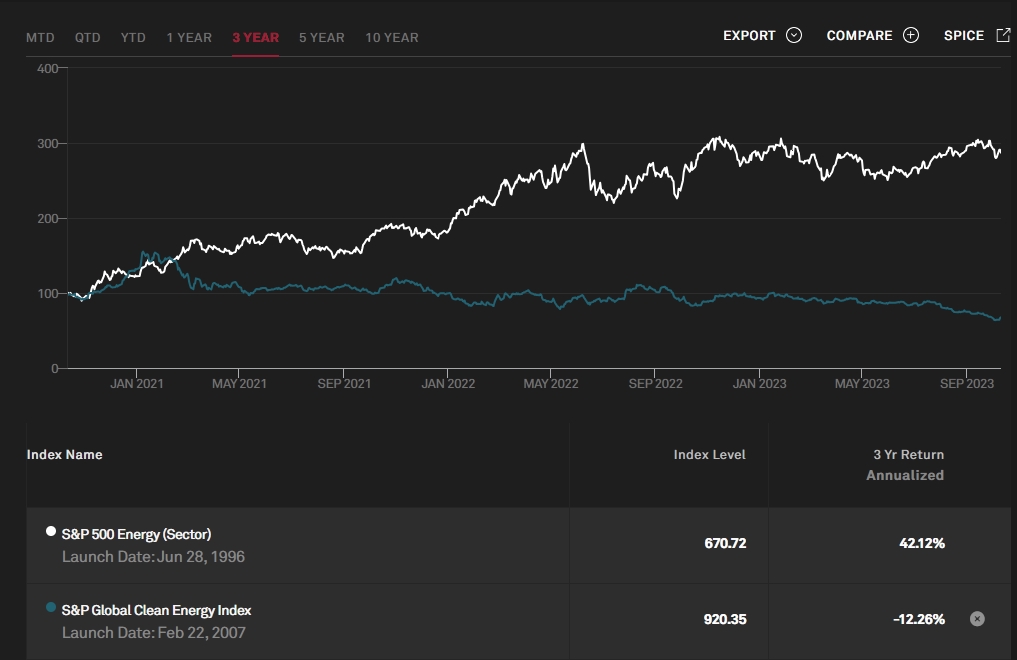 Energy Sector Index growth (white) compared to the Global Clean Energy Sector (green) in the last three years.
“The energy sector has been the best-performing market segment so far this month, with oil prices surging 30% over the past three months.” — Globe and Mail Yahoo Finance graphs the extraordinary growth of the S&P 500 Energy Index since 1994. Thanks to NetZeroWatch
By Jo Nova All flights are currently suspended at Luton Airport, London after a major fire broke out last night at 9pm. No one at the BBC, apparently, can explain why it spread so fast (the mystery!). But everyone is grateful this was not an underground carpark below, say, a 20 story apartment building with babies sleeping upstairs, especially since part of the top floor of the carpark has collapsed. The fire has, unfortunately demolished some dreams of carbon reduction. UPDATE: Apparently the word is that it was a diesel car that started the fire. The question is then, if there were no EV’s on that floor, would it have spread just as fast, would the floor have collapsed, and would cars have exploded like popcorn in the microwave? Awaiting the BBC gurus…
Hear the sound of cars exploding:
Luton Airport flights suspended after large car park fireBy Greg McKenzie and Emily McGarvey, BBC News All flights at London Luton Airport have been suspended and people have been asked not to travel there because of a large fire in a terminal car park. The Terminal Car Park 2 suffered a “significant structural collapse”, Bedfordshire Fire Service says. Up to 1,200 vehicles may have been in the car park and subsequently damaged, the fire service said. Four firefighters and a member of airport staff were taken to hospital for smoke inhalation. Russell Taylor, 41, an account director from Kinross, saw the flames after flying in to London Luton from Edinburgh. He told the PA news agency: “There were a couple of fire engines with a car ablaze on the upper floor of the car park at just after 9pm. “A few minutes later most of the upper floor was alight, car alarms were going off with loud explosions from cars going up in flames.” h/t GaryS |
||||
|
Copyright © 2025 JoNova - All Rights Reserved |
||||






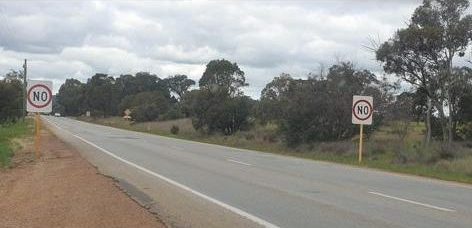
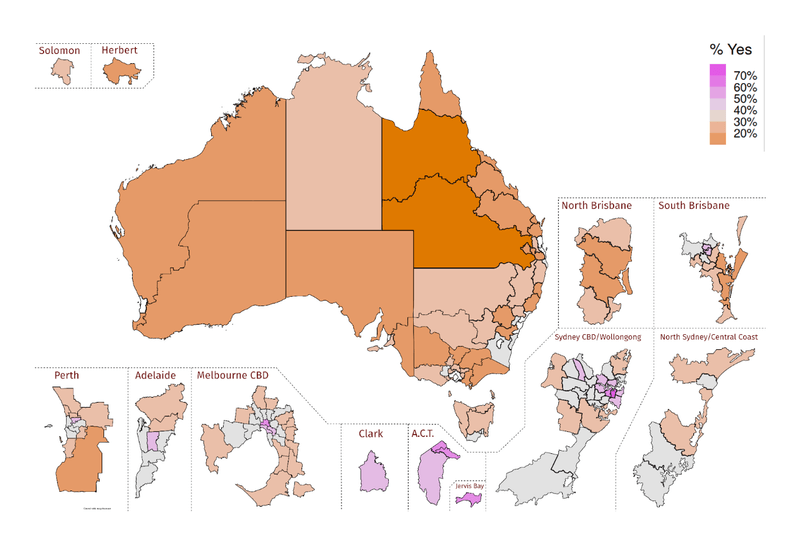
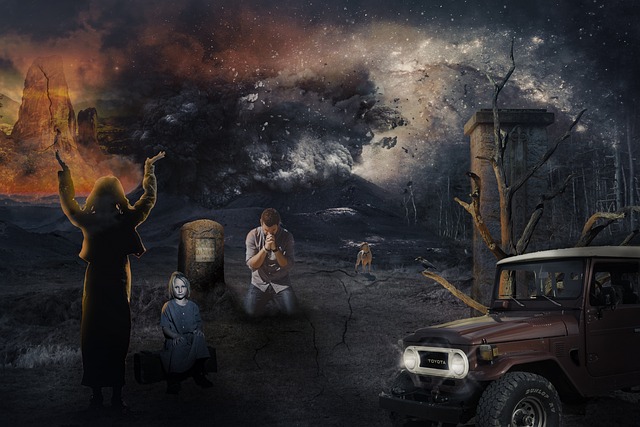

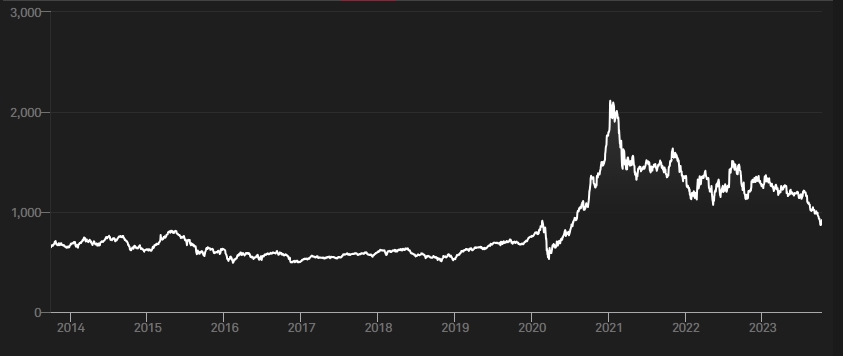




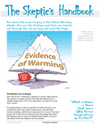






UPDATE #2: Allegedly there were no sprinklers (which wouldn’t put out an EV battery fire anyway). Let’s try to imagine what kind of sprinkler system would contain those EV Fires — like drop-down glass-fibre spray that solidifies on contact or like jet sprayed asbestos?
UPDATE #3: As many as 1,500 cars were in the car park, it’s not clear how many survived. Fireman say all four floors pancaked in at least one part. *See the video of the supposed start of the fire. And footage where the car is visible. Seems like a very big explosion. Some are saying it was a hybrid diesel.
Let your imagination run …